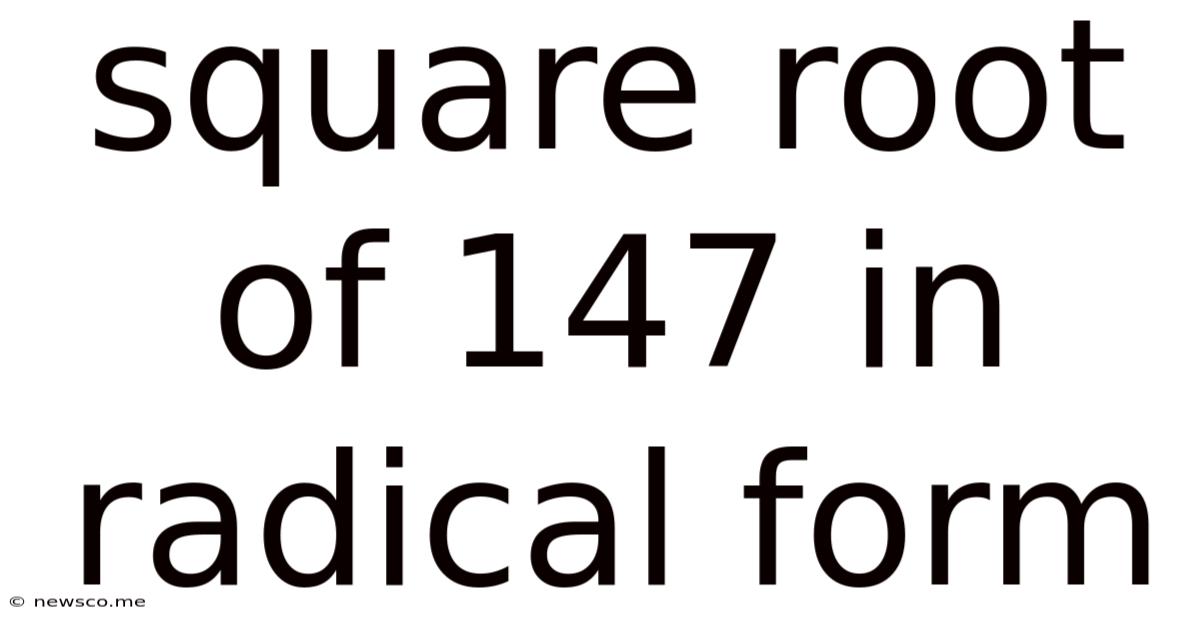Square Root Of 147 In Radical Form
News Co
May 07, 2025 · 4 min read

Table of Contents
Square Root of 147 in Radical Form: A Comprehensive Guide
The square root of 147, often represented as √147, might seem like a simple mathematical concept, but understanding how to simplify it into its radical form reveals a deeper understanding of number theory and algebraic manipulation. This comprehensive guide will not only show you how to find the simplest radical form of √147 but also delve into the underlying principles, providing you with a robust foundation for tackling similar problems. We'll explore different methods, address common misconceptions, and offer practical examples to solidify your understanding.
Understanding Radicals and Simplifying Square Roots
Before we dive into the specific case of √147, let's establish a firm understanding of radicals and the process of simplification. A radical expression is a mathematical expression containing a radical symbol (√), indicating a root (square root, cube root, etc.) of a number. Simplifying a radical expression means expressing it in its most concise and manageable form, eliminating any unnecessary factors within the radical.
Key Principle: The simplification of square roots hinges on the property √(a * b) = √a * √b, where 'a' and 'b' are non-negative numbers. This property allows us to break down a larger number into smaller factors, making simplification easier. We are specifically interested in finding perfect square factors. A perfect square is a number that can be obtained by squaring an integer (e.g., 4 = 2², 9 = 3², 16 = 4², etc.).
Method 1: Prime Factorization to Simplify √147
This method involves breaking down the number 147 into its prime factors. Prime factorization is the process of expressing a number as a product of its prime factors (numbers divisible only by 1 and themselves).
-
Find the prime factorization of 147:
147 is divisible by 3 (147/3 = 49). 49 is 7². Therefore, the prime factorization of 147 is 3 x 7².
-
Apply the square root property:
√147 = √(3 x 7²) = √3 x √(7²)
-
Simplify the perfect square:
√(7²) = 7
-
Final simplified radical form:
Therefore, the simplest radical form of √147 is 7√3.
Method 2: Identifying Perfect Square Factors Directly
This method is quicker if you can readily identify perfect square factors of the number.
-
Identify perfect square factors:
We know that 49 (7²) is a factor of 147 (147/49 = 3).
-
Rewrite the expression:
√147 = √(49 x 3)
-
Apply the square root property:
√(49 x 3) = √49 x √3
-
Simplify the perfect square:
√49 = 7
-
Final simplified radical form:
Again, the simplest radical form of √147 is 7√3.
Why Simplifying Radicals is Important
Simplifying radicals is not merely an academic exercise; it has practical applications across various mathematical fields. Here's why:
-
Clarity and Conciseness: Simplified radical forms are easier to understand and work with than unsimplified ones. This is crucial for clear communication and efficient problem-solving.
-
Accuracy in Calculations: Working with simplified radicals minimizes errors in calculations involving radicals, ensuring accuracy in results.
-
Standard Form: Simplifying radicals ensures that results are presented in a standardized form, facilitating comparison and collaboration among mathematicians and students.
-
Foundation for Advanced Concepts: Understanding radical simplification forms the basis for more complex mathematical concepts in algebra, calculus, and beyond.
Common Mistakes to Avoid When Simplifying Radicals
Several common mistakes can lead to incorrect simplification of radicals. Let's address some of them:
-
Incorrect Prime Factorization: Incorrectly factoring a number will lead to an incorrect simplified form. Always double-check your factorization to ensure accuracy.
-
Ignoring the Perfect Square: Failing to identify and extract perfect square factors from the radical is a frequent error. Always look for perfect squares (4, 9, 16, 25, etc.) within the number.
-
Improper Application of Radical Properties: Misusing the properties of radicals, especially √(a*b) = √a * √b, can lead to mistakes. Ensure you apply these properties correctly.
-
Not Simplifying Completely: Leaving the radical in a partially simplified form is an incomplete answer. Always simplify the radical to its most basic form.
Advanced Applications and Extensions
The concept of simplifying radicals extends beyond basic square roots. It applies to cube roots, fourth roots, and higher-order roots. The underlying principle remains the same: identify perfect nth-power factors (where 'n' is the order of the root) and simplify them outside the radical.
Furthermore, simplifying radicals is essential when working with:
-
Algebraic expressions: Expressions involving variables and radicals require similar simplification techniques.
-
Solving quadratic equations: The process often involves simplifying radicals to express the solutions accurately.
-
Geometry: Calculations involving lengths, areas, and volumes often involve radicals that require simplification.
-
Trigonometry: Many trigonometric identities and calculations involve radical expressions.
Conclusion
Simplifying the square root of 147, resulting in 7√3, illustrates a fundamental concept in mathematics. Mastering the techniques of prime factorization and identifying perfect squares empowers you to simplify various radical expressions accurately and efficiently. Understanding these methods and avoiding common errors forms a strong foundation for tackling more advanced mathematical concepts and problem-solving in various fields. Remember the importance of accuracy and complete simplification, always ensuring your answer is in the simplest, most concise radical form possible. The process, while seemingly simple, reveals the elegance and power of fundamental mathematical principles. Consistent practice will solidify your understanding and make simplifying radicals second nature.
Latest Posts
Related Post
Thank you for visiting our website which covers about Square Root Of 147 In Radical Form . We hope the information provided has been useful to you. Feel free to contact us if you have any questions or need further assistance. See you next time and don't miss to bookmark.